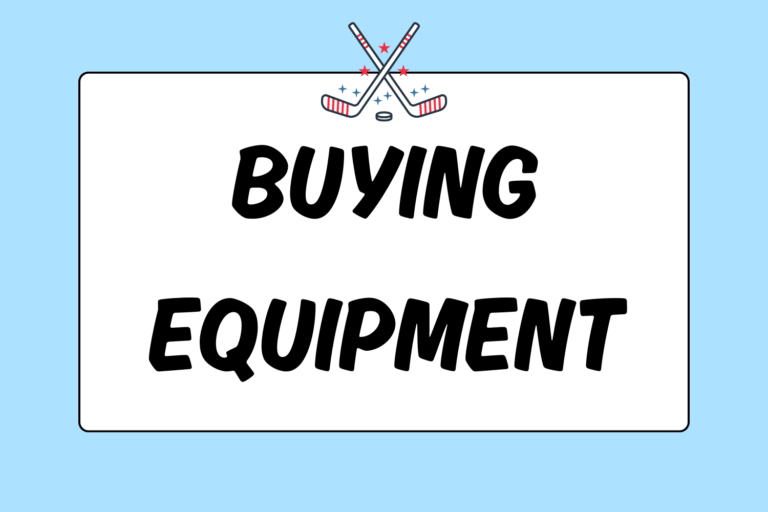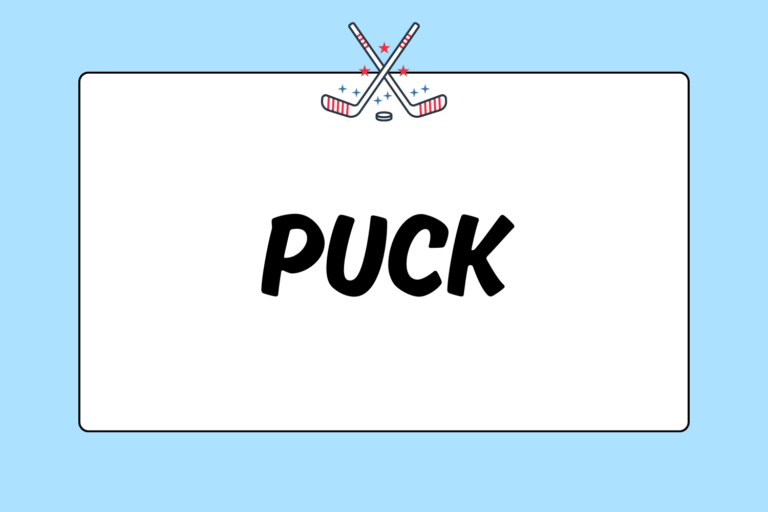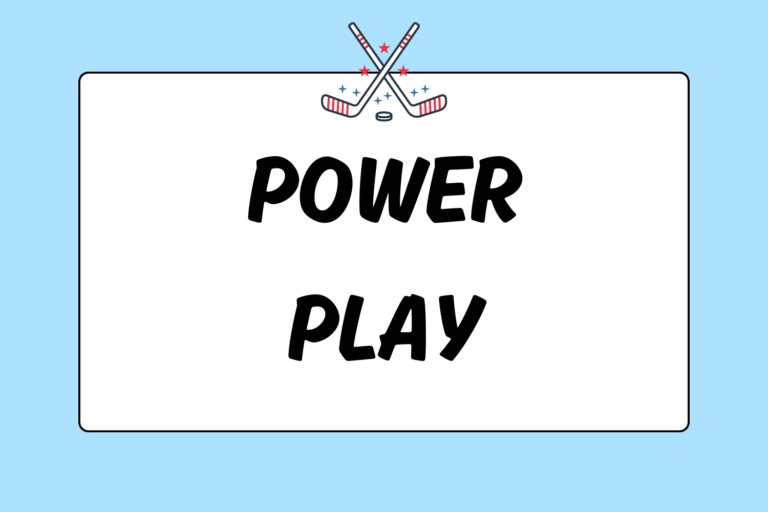The major difference between ice hockey and essentially every other sport is, well, the ice. The use of ice and skates is what makes hockey one of the fastest sports in the world. Players can reach their maximum speed after just a few strides and then coast at high speeds while conserving energy.
While hitting the ice for the first time can be nerve-racking, prospective players should know that ice skating is much easier than they might think. In this guide, we’ll examine all the terminology and techniques that you’ll need the first time you step on the ice.
Anatomy of an Ice Hockey Skate
Before addressing the details of what to do, let’s look at the components that every ice hockey skate has and learn some of the terminology that will help master beginner ice skating.
- Boot: This is the part of the skate that your foot goes into. It has a tongue, eyelets, and laces just like a regular shoe, but is way more rigid. Hockey skate boots are made from a combination of plastics, light metals, genuine/synthetic leather, cotton, and nylon.
- Tongue: The tongue on an ice skate is extra long and slightly reinforced. It extends well above the ankle and protects the front of the foot and lower shin.
- Toe cap/box: The toe cap (sometimes called the toe box) on a hockey boot is reinforced to the point of it being very hard. This is to protect the toes and front part of the foot from pucks, sticks, skates, and even the boards that surround an ice hockey rink.
- Tendon guard: Ice hockey skate boots extend much higher from the heel than on most shoes. This rigid part of the skate is called the tendon guard and it serves to both protect the back of the foot and add support.
- Laces: Hockey laces are like extra durable shoe laces, though are sometimes completely coated in wax. The wax makes the laces grip the eyelets and prevents them from loosening.
- Skate holder: The skate holder is the molded plastic piece that is attached to the boot via rivets and holds the skate blade in place.
- Runner/blade: The runner, or blade, is the stainless steel portion of the skate that makes contact with the ice. Blades are sharpened by carving out a concave hollow through the center of the blade lengthwise. This creates two sharp edges per blade. To differentiate between the two, one is referred to as the “inside edge” and the other as the “outside edge.” The majority of skating takes place on the inside edge.
Fun Fact
The physics of ice skating might not be what you expect. For decades, it was believed that the pressure and friction a skate made on contact melted the ice and allowed the skate to glide across a thin layer of water (which then refroze almost instantly). Scientists disproved this theory when they learned that the pressure/friction created by an ice skate was not nearly enough to melt frozen ice.
An answer would elude the physics (and hockey) community until the 2002 Winter Olympics in Salt Lake City, Utah, when renowned chemist Gabor Samorjai did scientific studies to help create the fastest ice surfaces the world had ever seen. In his work, Samorjai discovered that all ice has an ultrathin molecular layer with liquid properties. This molecular layer is actually what ice skates glide across, allowing us to play the game we love!
Lacing Up Your Skates
Comfortable ice skating is achieved when the skate acts like an extension of the foot. When tying your skates, the first few crosses (down by the toe) should be taut, but not tight. When you’re about four or five eyelets from the top of the skate, you should start pulling the crosses very tight. This gives the ankle the support it needs, and allows proper power transfer from the leg to the ice.
Many players choose not to lace up the top eyelet; this is largely a point of personal preference. Always tie a double-knot. If the laces are very long, wrap hockey tape around the ankle and excess laces to ensure they don’t come untied or get caught under the skate blade. Keep in mind that the skate is supposed to feel tight. However, if during play the skate becomes uncomfortable, feel free to try tying it a bit looser. Many children will have trouble tying their laces by themselves. Parents should help. Also, skate lace tightener tools (or “Skate Keys”) are available. Young hockey players should be encouraged to learn to dress themselves as soon as they are able to properly do so.
The First Step
So you know about skates and how to get them on. Now let’s get on the ice! Some things to remember when you’re taking your first step:
- Skates flat: Keep your skates flat on the ice and try to keep your weight on the balls of your feet instead of your heels. Fight the urge to lean forward.
- Knees/ankles bent: Bend both your knees and your ankles. A forward bend in the ankles is good; however, a side-to-side bend is bad. If your ankles bend outward, you should retie your skates even tighter.
- Arms up: When you’re first learning to skate, it’s okay to keep your arms out for balance. Eventually, your legs, ankles, and feet will do most of the stabilizing, but don’t rush things.
- Hold on: It’s more than okay to hold on to the boards, a parent, a coach, or a more experienced friend until you develop enough balance to go off on your own.
Basic Forward Push
The most basic way to skate forward is to angle one of your toes slightly outward and apply pressure to the inside edge of that foot’s blade. This should propel you forward. Keep your other skate blade on the ice for balance and let it guide you. You will go in the direction this skate is pointing. Continue to hold onto something if you need to. Do it again. Keep pushing off that same skate for a while.
Once you’ve got the hang of pushing with one of your feet, switch things up and use the other. When you feel comfortable pushing off of either skate, try stringing the movements together and alternate the pushing foot with each stride. As you start going faster, you may find it more comfortable to lean a bit forward and to pump with your arms as though you were jogging.
Skate Drag
Now that you’re skating, you’d better learn to stop. The easiest way to put on the brakes is by utilizing a skate drag. A skate drag is very similar in stance to the basic forward push, but it will slow you down to a stop. As you’re gliding forward with your front skate leading the way, simply drag the inside edge of your back skate across the ice behind you. It’s impossible to stop on a dime with a skate drag, but it’s a simple tool that will help you early on.
The V-Stop
Another easy way to stop is by utilizing a V-stop. As you’re skating forward, slightly angle your knees and toes together. It’s called a V-stop because the shape your skates make as they shred across the ice (loosely) looks like a V. Keep your knees bent and lean back just a little. You should feel the inside edges of both skates shave across the ice and slow you down gradually. Be careful not to put too much weight on that inside edge, or it will bite into the ice and you may fall.
The V-stop, while valuable to new skaters, will be replaced by other stopping techniques as the skater’s skill increases (with the exception of goaltenders, who will still use it occasionally).
Basic Turning
The most basic turns involve keeping both skate blades on the ice, but shifting slightly to the outside edge of the skate in the direction you want to turn. For example, if you want to turn left, lead with your left foot and shift to its outside edge. Start slow. Once you’ve got the hang of turning both left and right, try your basic forward push with your trailing foot.
The Next Day
Your muscles will ache – plain and simple. The day after your first time ice skating, you will be sore in muscles you didn’t even know you had. You should stay relatively active. Ride a bike or go for a walk. Stretch. While it may be counterintuitive, some light exercise will help your muscles recover. Just know that the more often you skate, the less sore you’ll be after skating. Go out and hit the ice again soon!





